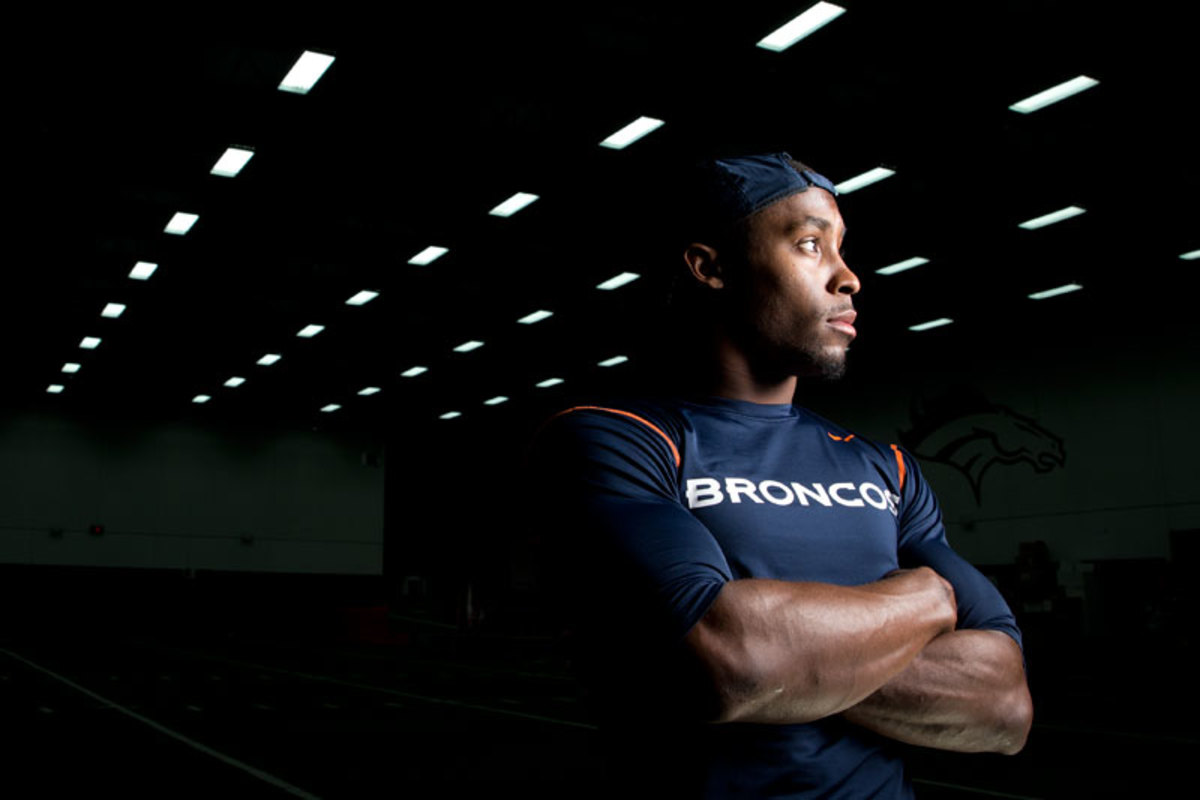There Are Some Things Rahim Moore Doesn’t Want to Remember

ENGLEWOOD, COLO. — The scar spreads down the outside of Rahim Moore’s left calf, scaly and black. It’s never narrow, but oh, is the middle part wide. It’s a messy scar, jagged in some places, bulging in others, working its way down 13 inches of his leg before thinning again and tapering to smooth flesh.
Moore rubs ointment over its ridges. He wants it to fade. He wants the memories to recede, too, because if that wasn’t the worst pain he’ll ever feel, well, he’d prefer not to explore other possibilities. As the Broncos’ starting safety tried to settle into bed in the wee hours on Nov. 18, he’d never felt anything so horrible as the burning, searing, throbbing pain that reduced him to tears. He didn’t know pressure was building to dangerous levels within a compartment of muscles, nerves and blood vessels in his lower left leg. But he knew it was bad. He woke up his girlfriend, who drove him to Sky Ridge Medical Center in Lone Tree, Colo.
Doing so saved Moore’s leg—and possibly his life.
Not 12 hours before, Moore had been getting ready for the Broncos’ Week 11 home game against the Chiefs. Coming off a so-so performance the previous week in San Diego, where he’d had just two tackles in a 28-20 win, the third-year pro out of UCLA believed he was poised for a breakout game. But during warmups his left leg began to feel strange. He started in his usual spot in the secondary, but as the first quarter unfolded, Moore never quite hit his stride, and that “off” feeling in his left calf morphed from discomfort he could ignore to crippling pain. By the second quarter, he begged out, and “Rahim Moore, leg injury” was announced in the press box.
No hit appeared to have caused the injury, but few thought anything of it. Moore’s mother, Nowana Buchanan, didn’t even notice her son’s absence as she watched from the stands. It seemed innocuous: a bruise, a cramp, perhaps dehydration at high altitude. On Monday morning, however, interim head coach Jack Del Rio opened the Broncos’ team meeting with the staggering news: Overnight, Moore had undergone emergency surgery for compartment syndrome—a condition Del Rio admitted never hearing of.
Del Rio said Moore would be out for six to eight weeks, but that prognosis turned out to be overly optimistic. Moore didn’t play again in 2013. He didn’t run until January. His leg was weak and withered, “a baby leg” he called it. And yet here he is six months later, sitting in a room at the Broncos’ training facility, rolling up his workout pants to reveal a left leg that looks as strong and muscular as any other NFL defensive back’s—except for that jagged, bulging, messy scar.
* * *
Justin Edmonds for The MMQB

Compartment syndrome is a rare condition that occurs when pressure builds to extreme levels within muscles. In layman’s terms, swelling occurs, trapping excessive pressure in compartments that we all have in our muscles, which are contained by strong connective tissue called fascia and have a finite amount of room to expand. As blood keeps flowing in and the flow out decreases, pressure mounts, and the surrounding area is deprived of nourishment. Cells die off as the blood flow becomes restricted or cut off entirely, damaging or even killing the affected muscles.
The syndrome occurs in two capacities: chronic and acute. Chronic compartment syndrome is often exercise-induced, leading to increased pain as workouts intensify. The pain subsides once the muscles are no longer being exerted, though damage still builds up. Acute compartment syndrome is another beast entirely. A major injury, such as a broken leg, is usually the culprit; the blunt trauma typically causes pressure to build up quickly and destructively. “That’s a real emergency,” says Rams team physician and president of the NFL Physicians Society Dr. Matthew Matava, who has never treated an instance of compartment syndrome in a football player.
Moore, however, never suffered a traumatic leg injury. He woke up the Sunday morning of Denver’s game against Kansas City feeling fine, going through his normal pregame routine and having the team’s athletic trainers work on his body as they would any other game day. Then the defensive backs began their drills. Up and down the field they ran, sharpening their footwork, getting their leg muscles primed. In one drill, Moore cut to the side, felt a pinch, and his foot seemed to melt away. This was no longer the kind of dull pain his mind could block out, and he immediately turned to fellow safeties Mike Adams and Duke Ihenacho and told them he might not be able to play.
Even so, Moore took the field. Three minutes in, on Kansas City’s second series, he broke up a long pass from Alex Smith to Donnie Avery, and when he got up, Ihenacho patted him on the rear end. Moore didn’t reciprocate, deflecting the praise. Had it been any other day, he knew he could have picked off the ball.
“After that, I mean, my ankles are bad and stuff, and I’m hurting the team,” Moore recalls. “I can’t stay in much longer. I just decided to come out. I got an X-ray, and they told me there was no broken bone, no fracture, and I was like, ‘Cool. OK—what else in the world can it be?’ ”
You are not cutting my leg off,” Moore told doctors. “That’s not happening.
There was little cause for alarm. The pain subsided, and Moore went to dinner with his family after the Broncos’ 27-17 victory. He and his girlfriend drove home to his house in the suburbs, and his mother, uncle and pastor—all in town from California for the weekend—returned to their hotel in downtown Denver. As Moore got ready for bed, though, the pain returned. He began icing his leg, but that didn’t help. Neither did Tylenol.
“All of a sudden, my leg just got weak,” Moore says. “I felt like I had about 30 Band-Aids on my knee, and there was no feeling down my leg. I started to tear up, and I was like, What’s going on?”
At Sky Ridge Medical Center, doctors diagnosed him with acute compartment syndrome, which can also arise from vigorous exercise and explains why the pain returned with such fervor several hours after he’d last been active (the symptoms would have dissipated if it were chronic compartment syndrome).
Cases like Moore’s—acute compartment syndrome with no broken bone—are rare, and timing is always of the essence. Almost immediately, doctors performed a needle test to gauge the pressure, which left no doubt that compartment syndrome was besieging his leg. Doctors told Moore that had he waited to come in until noon on Monday, they would have had to amputate. Any longer than that, he could have died.
Moore simply told them, “You are not cutting my leg off. That’s not happening.”
* * *
There Are Some Things Rahim Moore Doesn’t Want to Remember
Chiefs wideout Dwayne Bowe pulls down a catch in between Rahim Moore (26) and Duke Ihenacho last Nov. 17 at Sports Authority Field at Mile High. (Doug Pensinger/Getty Images)

Justin Edmonds for The MMQB

Justin Edmonds for The MMQB

On his way to the hospital, Moore called the Broncos’ vice president of security, Keith Bishop, and asked him to alert head athletic trainer Steve Antonopulos and team physician Dr. Martin Boublik. (Both declined to be interviewed for this story.) Well past 2 a.m., it took several calls for Moore to wake up his mom, who made it to Sky Ridge just in time to see her son, already sedated, before he was wheeled into surgery.
When Moore woke up afterward—doctors performed a fasciotomy to release the pressure and clean out any dead or dying muscle—he was still in disbelief. His leg was already withered and weak, and doctors told him to use a walker to get around. This, of course, didn’t stop him from scooting up and down the hallway outside his room, feebly attempting to do lunges and dips.
Moore spent three nights in the hospital, and about two weeks later he returned to have more dead tissue cleaned out of his leg, which wasn’t scabbing properly. Doctors also released more pressure from the compartment, and they didn’t close the sliced-open leg for three days in order to let the wound drain. With that setback, Moore’s chances of returning for the AFC Championship Game all but disappeared—though he held out hope. In late December, he began reporting to the Broncos’ training room to work with Antonopulos, nicknamed “Greek,” to strengthen his leg.
“Each and every day, I approached it as if I was going on the football field,” Moore said. “I told Greek, This is my field now, and you’re my coach.”
Oooh, Rahim,” Nowana Buchanan told her son, “the Lord’s given you a whole new leg.
The two worked extensively on single-leg strengthening first, and then aimed to build the muscles in both of Moore’s calves. Now, he points to his left leg and brags about its girth, and he can’t help mentioning that the right one is also stronger than it was, and that he’s put on about seven pounds of muscle since last fall. In the offseason, once Moore was back to something approaching football shape, he did sand workouts and ran hills, using his surplus of free time to go above and beyond the trainers’ workouts. He says he feels like a rookie again.
“He’s fattened up a little bit,” Moore’s mother says. “I said, ‘Oooh, Rahim, the Lord’s given you a whole new leg.’ ”
“I didn’t know if I would ever walk again,” says Moore, who often turned to his faith during the rehab process. “I didn’t know if I would ever be the Rahim that I know I can be, and also be able to have the footwork and be swift and things like that. The Lord definitely restored me.”
By all accounts, Moore has recovered completely, and one look at his leg confirms that he’s back in peak physical shape. He’s hoping to return to the condition he was in before the injury—he logged 44 tackles, six passes defensed and two interceptions in nine full games last year—and the Broncos will need him to be all that and more on a defense that was beaten down and exposed by the Seahawks in the Super Bowl.
The odds of compartment syndrome recurring are less than 15 percent, Matava says, so for all the wondering why it happened and what caused it, Moore isn’t going to worry—and he has no desire to reminisce. Some people embrace pain, believing it can make them stronger, but sometimes it’s just better to forget the whole ordeal. That’s why Moore so diligently applies the ointment. As the scar fades, so, too, will the memories.

